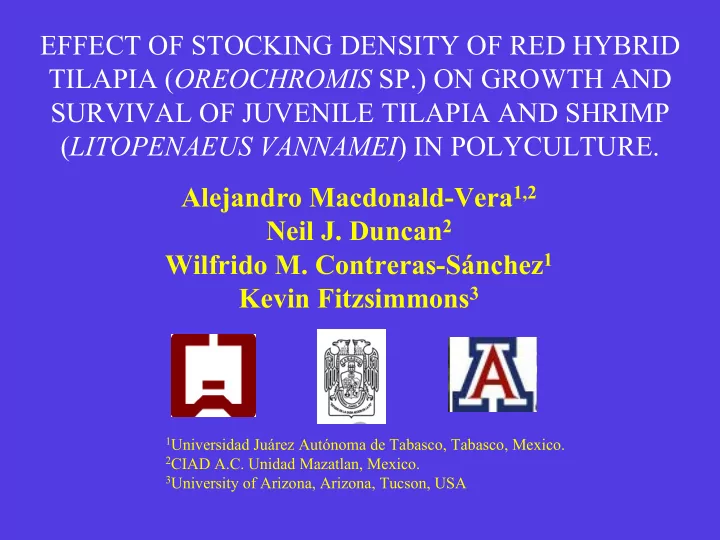

EFFECT OF STOCKING DENSITY OF RED HYBRID TILAPIA ( OREOCHROMIS SP.) ON GROWTH AND SURVIVAL OF JUVENILE TILAPIA AND SHRIMP ( LITOPENAEUS VANNAMEI ) IN POLYCULTURE. Alejandro Macdonald-Vera 1,2 Neil J. Duncan 2 Wilfrido M. Contreras-Sánchez 1 Kevin Fitzsimmons 3 1 Universidad Juárez Autónoma de Tabasco, Tabasco, Mexico. 2 CIAD A.C. Unidad Mazatlan, Mexico. 3 University of Arizona, Arizona, Tucson, USA
• Shrimp Farming Industry in Mexico. – Industry is prospering. – Disease and pricing problems. – Inefficient farms stop operating. Alejandro Macdonald-Vera who completed the study. – Over 5000 ha of shrimp ponds unused. • Shrimp-Tilapia polyculture. – Increased production. – Maintain or improve shrimp survival. – Remove disease carriers from system. Shrimp ponds in Mexico.
Methods • White shrimp – PL 16 - 0.004g – Litopenaeus vannamei – Certified free from white spot • Red hybrid tilapia - 4.6±0.9g – Genetic component of Oreochromis mossambicus Pond preparation, ploughed and limed. – All males (hormonal treatment) – Acclimatised to 35ppt sea water, 5ppt per day. • Pond preparation. – Salinity range - 28 to 35 ppt – Temperature range - 16.2 to 25.6°C Mosquito mesh divisions to make experimental enclosures
Methods experimental design Block B Block A Block C outlet Water 4 3 9 6 5 2 1 8 7 inlet. 0.25 0.25 0.25 0.5 0.5 0 0 0 0.5 Experimental pond set up. • 9 enclosures (7x30=210m 2 ) in 3 blocks, A, B, C. • All enclosures stocked with 30 shrimp/m 2 • Tilapia stocked at 3 densities, 0, 0.25, 0.5 fish/m 2 to give the experimental groups T0, T0.25 and T0.5
Methods • Stocking – Shrimp and tilapia were acclimatised and randomly stocked into each enclosure. • Sampling. – Every 2 weeks. Stocking. – 20 tilapia caught and weighed. – 30 shrimp weighed. • Harvest. – Experiment lasted for 8 weeks. – All shrimp and tilapia were harvested, counted and a random sample weighed. Sampling.
Results - Statistics NEWVAR16 Shapiro-Wilk W=.97691, p<.0002 • Weight data was not normal. 120 Shrimp 110 100 – Some shrimp weight 90 distribution 80 distributions were highly 70 No of obs 60 skewed towards larger 50 40 individuals. 30 20 – Some tilapia weight 10 VAR7 Expected 0 Normal distributions had 0.5 1.0 1.5 2.0 2.5 3.0 3.5 4.0 7 Upper Boundaries (x <= boundary) characteristics of a bimodal 6 distribution, 23 to 42% 5 maturing females were found 4 during the harvest. 3 No of obs • 2 way Scheirer-Ray-Hare 2 Tilapia extension of the Kruskal-Wallis 1 Expected distributions 0 and the DUNNS test were used Normal 15 20 25 30 35 40 45 50 NEWVAR13 Upper Boundaries (x <= boundary) Shapiro-Wilk W=.97111, p<.0110 to compare weight distributions 35 30 25 • Survival distributions were 20 No of obs normally distributed and were 15 10 compared with ANOVA. 5 Expected 0 Normal 14 16 18 20 22 24 26 28 30 Upper Boundaries (x <= boundary)
Results – Tilapia Growth. 50 45 40 35 Weight (g) 30 25 20 15 10 5 0 5 Dec 22 Dec 5 Jan 19 Jan 2 Feb No significant differences were observed for tilapia weights among treatments T0.25 and T0.5 or blocks A, B and C.
Results – Shrimp Growth. 3 2.5 2 Weight (g) 1.5 1 0.5 0 5 Dec 22 Dec 5 Jan 19 Jan 2 Feb No significant differences were observed among treatments T0, T0.25 and T0.5
Results – Shrimp Growth. 3.0 b Block A b 2.5 a Block B 2.0 ab b Weight (g) Block C a 1.5 b a 1.0 a 0.5 a a a 0.0 22 Dec 5 Jan 19 Jan 2 Feb Significant differences (P<0.05) were observed among blocks A, B and C.
Results – Survival. 100 a a a a a 90 80 b Survival % a a 70 a 60 a a 50 40 30 20 10 0 Block Block Block T0 T0.25 T0.5 Block Block Block T0 T0.25 T0.5 A B C A B C Shrimp Tilapia There were no significant differences among tilapia survivals. There were no significant differences among shrimp survivals for treatments, T0, T0.25 and T0.5. There were significant differences (p<0.05) among shrimp survivals for blocks A, B and C.
Conclusions • Stocking densities of 0, 0.25 and 0.5 fish/m 2 did not significantly affect growth or survival of juvenile shrimp and tilapia. • Block or position in the pond did significantly affect (p<0.05) growth and survival of juvenile shrimp. • These are encouraging results that suggest shrimp tilapia poly-culture has good potential for diversifying the Mexican shrimp culture industry and rehabilitating disused shrimp ponds.
Gracias CRSP Juan Manuel Gonzalez and his family • Gabriela Velasco • Michael Achury • Leonardo Ibarra • Noemi Garcia • Rafael Guzman • Estela Rodriguez. • Ricardo Alvarez
Recommend
More recommend